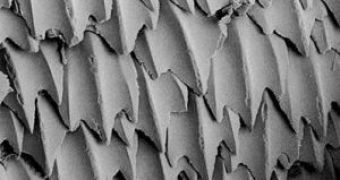Have you ever touched shark skin? It is very abrasive, like sand paper.
This is due to a special type of scales, called placoid ("slate-like") (photo: scales of great white shark), very similar structurally to teeth and carrying tiny ridge-like structures. The tiny ridges arranged parallel to the swimming direction - known as "riblets" - decrease drag in water, explaining the amazing speed that some sharks reach with minimal effort.
A new coating system is to imitate this "riblet effect", known to scientists for more than 50 years, in order to improve the aerodynamics of vehicles, ships and aircraft. Some films applied to the outer surfaces would reduce frictional resistance and bring down fuel consumption. But these films can only be applied to flat or convex surfaces, while bodies whose aerodynamic or hydrodynamic properties have been optimized tend to have a more complex shape.
The alternative to film coating is to texture the surface itself with riblets. However, none of the laser or milling techniques used so far are suitable for components that have to be painted, as the paint would immediately flow into the tiny grooves and fill them.
Dr. Volkmar Stenzel of the Fraunhofer Institute for Manufacturing Engineering and Applied Materials Research IFAM (Germany) came up with the idea of integrating the riblet pattern into the lacquer itself. "That meant we had to look for a tool which didn't adhere to the lacquer, so that it could impress the required structure onto it," explains Stenzel.
A new prototype combines a suitable lacquer and the technology for applying it. An approximately 20 cm wide transparent silicone film with a riblet pattern serves as a "stamp", capable of printing patterns with a resolution of a few nanometers, similar to those found in holograms. The film runs over three flexible rollers and can thus adapt its shape to hug uneven surfaces. From the front, a new type of resin lacquer is continuously sprayed onto the film and transferred with the help of the rollers onto the surface to be treated. A UV lamp then turns hard the resin in a fraction of a second.
Because of the extremely fast application and hardening process, the riblet structure is retained. "Our trial lacquer is based on the chemistry used in aviation paints. It is mechanically very durable and," Stenzel hopes, "should also be resistant to strong UV radiation at high altitude."
A field trial will soon show whether the lacquer fulfills its promise in practice. Stenzel stresses that the new technology is not restricted to planes: "With this technology we can apply any other micro and nano structures to lacquered surfaces."

 14 DAY TRIAL //
14 DAY TRIAL //